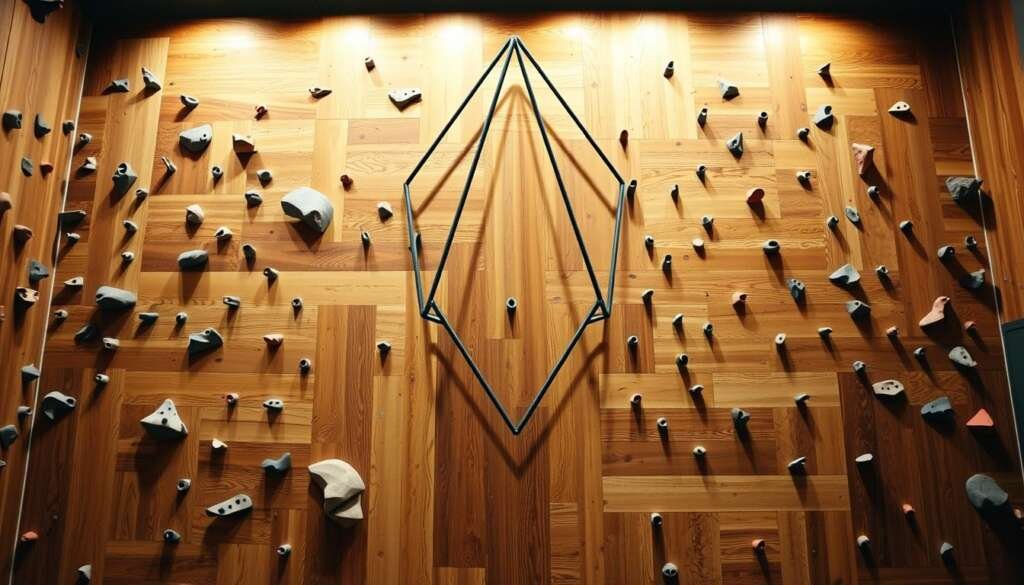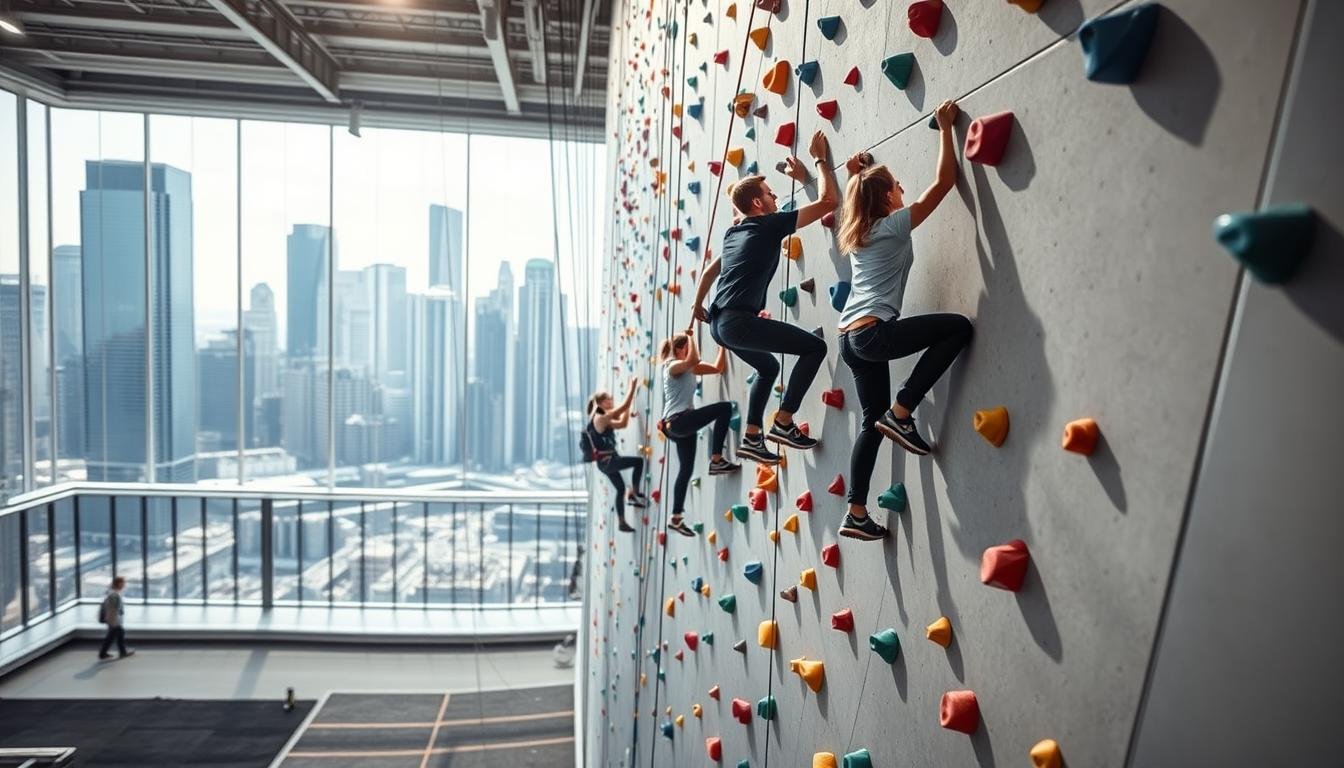Indoor climbing has exploded in popularity, with over five million enthusiasts now scaling walls across the United States. Stars like Chris Sharma and Margo Hayes have transformed this niche activity into a mainstream passion. Their influence, combined with cutting-edge developments, pushes boundaries for climbers of all skill levels.
Gym owners and equipment creators face exciting challenges as the sport evolves. Events like the annual Climbing Wall Association conference in Colorado reveal groundbreaking ideas – from smart holds that track progress to eco-friendly wall materials. These innovations prioritize safety while keeping the thrill alive.
Modern facilities now blend tech with classic techniques. Auto-belays let newcomers learn safely, while augmented reality routes test veterans’ creativity. This mix preserves climbing’s adventurous spirit while welcoming diverse crowds.
Accessibility drives many recent changes. Adaptive climbing programs and inclusive design prove the sport isn’t just for elite athletes. As walls appear in urban centers and schools, more people discover climbing’s physical and mental benefits.
Key Takeaways
- Over 5 million Americans regularly participate in indoor climbing activities
- Major conferences drive innovation in safety equipment and facility design
- Technology enhances training while maintaining traditional climbing values
- New adaptive programs make the sport accessible to diverse populations
- Urban climbing gyms introduce the activity to broader audiences
The Evolution of Indoor Climbing Halls
Urban centers across America now host multiple climbing facilities within single zip codes. This density signals a turning point for gym owners – simply having walls and ropes no longer cuts it. Emily Moore from the CWA conference puts it bluntly:
“Your ‘why’ matters more than your square footage now. Members choose gyms that mirror their values.”
Shifting Market Dynamics and Business Models
The climbing industry’s growth spurt has cooled. Early adopters thrived on passion alone, but today’s gyms need business savvy. Successful operators now blend route-setting skills with marketing analytics. Many facilities invest in leadership training programs, recognizing that staff engagement drives customer loyalty.
Consolidation looms as smaller gyms struggle to compete. Corporate chains leverage bulk purchasing power, while indie spots focus on niche communities. This split creates two distinct paths: scale-driven efficiency versus hyper-local authenticity.
Building a Unique Selling Point in a Saturated Market
Differentiation starts with listening. Top-performing climbing gyms conduct monthly member surveys and track usage patterns. Some facilities now offer:
- Parent-child climbing leagues with coaching
- Corporate team-building packages
- Themed boulder zones that rotate weekly
One Brooklyn gym doubled membership by hosting local artist showcases in their lounge area. Others partner with physical therapists to create injury-prevention programs. The magic happens when business strategy meets climbing culture authentically.
The Future of Climbing: Trends to Watch
Climbing facilities are getting smarter through tech upgrades that benefit rookies and experts alike. Modern walls now sense movement, adjust difficulty levels, and even cheer you on with LED light cues. These changes make practice sessions feel like interactive games while tracking progress.
Emerging Climbing Wall Technologies
Smart holds now analyze grip strength and suggest technique improvements. Walls with pressure sensors help climbers spot weaknesses in real time. Some gyms use color-changing routes that adapt to different skill levels during sessions.
Innovative Gym Designs and Safety Enhancements
New gym layouts feature crash pads with airbag technology and auto-locking carabiners. Architects blend natural rock textures with neon-lit training zones. One Denver facility reduced injuries by 40% using AI-powered fall prediction systems.
Integration of Digital Tools in Climbing Experiences
Mobile apps now match climbers with ideal routes based on past performance. Augmented reality glasses project virtual handholds onto practice walls. Over 60% of U.S. gyms use member apps for booking sessions and sharing achievements.
These upgrades create safer, more engaging environments. Climbers gain personalized feedback while gyms collect valuable usage data. The result? Spaces that grow with their communities while keeping the thrill intact.
Rethinking Climbing Gym Atmosphere and Customer Experience
The secret sauce for thriving climbing gyms isn’t just holds and ropes – it’s crafting spaces that feel like second homes. Operators now focus on emotional triggers that turn first-time visitors into regulars. Lighting that mimics golden-hour glow and playlists curated to match climbing intensity prove environment shapes behavior as much as route difficulty.
Leveraging Neuromarketing for Community Engagement
Forward-thinking gyms use limbic mapping to design spaces that spark joy and determination. A Seattle facility redesigned its lounge using warm wood tones and circular seating, boosting member hangout time by 70%. “People don’t remember grades – they remember how we made them feel,” notes owner Lila Chen.
Three key neuromarketing strategies are reshaping climbing businesses:
| Traditional Focus | Neuromarketing Approach | Result |
|---|---|---|
| Equipment upgrades | Mood lighting systems | 23% longer sessions |
| Route difficulty | Scent diffusion zones | 41% stress reduction |
| Staff certifications | Empathy training | 89% satisfaction scores |
Smart gyms now track emotional responses through post-climb surveys and heartbeat monitors. One Colorado chain found climbers who laugh during sessions renew memberships 3x more often. Training staff to read body language helps create supportive interactions that keep walls busy and communities strong.
“Our best marketing tool isn’t Instagram – it’s the energy when someone nails their first dyno.”
By blending psychology with passion, modern facilities build loyalty that tech alone can’t match. The right atmosphere turns challenging climbs into personal triumphs – and casual visitors into lifelong advocates.
Mini Bouldering Halls and Kiosk Innovations
Compact training spaces are reshaping how climbers approach skill development. Across U.S. cities, bright bouldering kiosks replace dim basement setups, offering focused practice zones. These micro-gyms prioritize natural light and strategic layouts that boost motivation.
Redefining Traditional Bouldering Spaces
The kiosk model thrives on efficiency. Operators pack multiple system walls into small footprints, letting climbers tackle varied routes side-by-side. Popular setups include:
| Feature | Traditional Gym | Modern Kiosk | Impact |
|---|---|---|---|
| Lighting | Fluorescent | Daylight LEDs | +37% session length |
| Wall Types | Single texture | Modular systems | 4x route options |
| Space Use | 2000+ sq ft | Under 800 sq ft | 50% lower costs |
Denver’s Ascent Kiosk proves the concept works. Their dual kilterboards host twelve climbers simultaneously in a former retail space. “We’re not selling memberships – we’re selling progress,” says owner Tessa Nguyen.
These hubs attract serious athletes seeking distraction-free training. With monthly fees 40% below standard gyms, kiosks make elite-level practice accessible. Urban planners now consider them essential infrastructure, like coffee shops for fitness communities.
“Our regulars complete 30% more attempts per hour compared to larger facilities.”
From Moonboard to Kilterboard: The Training Evolution
Training tools have undergone radical changes since Ben Moon revolutionized climbing walls with his numbered-hold system. What began as wooden panels with fixed angles now features app-connected smart boards that adapt to any skill level. This shift transforms how athletes prepare – and who gets to call themselves a climber.
Enhancing User Interaction with Ergonomic Design
Kilterboard’s adjustable walls solve a key problem: one-size-fits-all training. Their 15°-70° tilt range lets gyms host kids’ classes and pro sessions on the same wall. LED-lit holds glow brighter as routes intensify, creating instant visual feedback.
| Feature | Moonboard | Kilterboard | Advantage |
|---|---|---|---|
| Angles | Fixed 40° | Adjustable | Universal access |
| Holds | Standardized | Ergonomic shapes | Injury reduction |
| Lighting | None | Route-specific LEDs | Clear navigation |
Gym owners report 62% fewer finger injuries since switching to curved holds. “The old boxy edges shredded hands,” notes Salt Lake City coach Mara Lin. “Now climbers train harder, longer.”
Community-Driven Problem Setting and App Integration
Over 300,000 user-created routes live in the Kilter app. Climbers filter challenges by grade, style, or popularity – then share videos of their sends. This crowdsourced approach keeps walls fresh without staff input.
Denver’s Peak Fitness gym runs monthly virtual tournaments. Members compete against climbers in Tokyo and Berlin using identical board setups. “It’s like gaming culture met climbing,” says manager Drew Carter. “Membership renewals jumped 45% since we launched this.”
“Our app isn’t just a tool – it’s the world’s largest climbing club.”
Blending Nostalgic Aesthetics with Modern Design Trends
Climbing walls tell a visual story of technological progress. Fifteen years ago, gyms relied on untreated wood panels because vibrant coatings didn’t exist. Today’s walls burst with color and texture, yet some designers are circling back to organic elements – this time by choice.

The Transition from Natural Wood to Vibrant Coatings
Early climbing facilities used raw wood out of necessity. Limited coating options meant splintered surfaces and frequent repairs. “We spent more time sanding than setting routes,” recalls veteran route designer Marco Silva.
Modern resin-based coatings changed everything. These durable surfaces offer:
- Customizable grit levels for better grip
- UV-resistant colors that won’t fade
- Easy cleaning with basic equipment
Portland’s Vert Culture gym mixes eras brilliantly. Their feature wall combines reclaimed barn wood with glow-in-the-dark holds. “We’re not erasing history – we’re remixing it,” says owner Lila Chen.
| Feature | Natural Wood | Modern Coatings | Advantage |
|---|---|---|---|
| Lifespan | 3-5 years | 10+ years | Cost efficiency |
| Customization | Limited | Unlimited colors | Brand alignment |
| Safety | Splinter risks | Consistent texture | Injury reduction |
The industry’s maturation lets designers prioritize both function and mood. While 78% of new gyms use synthetic walls, many incorporate wood accents in lounges or feature areas. This balance honors climbing’s roots while embracing tomorrow’s possibilities.
Conclusion
Climbing’s evolution reflects a dynamic blend of tradition and innovation. Tech-driven solutions now coexist with chalk-dusted camaraderie, proving progress doesn’t erase passion. From adjustable training walls to neighborhood bouldering hubs, the industry reshapes itself while keeping roots in outdoor adventure.
Market saturation pushes creativity. Successful gyms merge data analytics with human connection – think LED-lit routes paired with mentorship programs. American climbing facilities lead this charge, balancing commercial needs with the sport’s raw appeal.
Community remains central to growth. Digital tools connect climbers globally, yet local spaces thrive through hyper-personalized experiences. Rock walls become canvases for both athletic triumphs and neighborhood gatherings.
The path forward? Embrace change without losing soul. As climbing gyms diversify offerings and designs, they create inclusive gateways to vertical worlds. This adaptive spirit ensures every ascent – whether first-timer or pro – fuels the next chapter.

